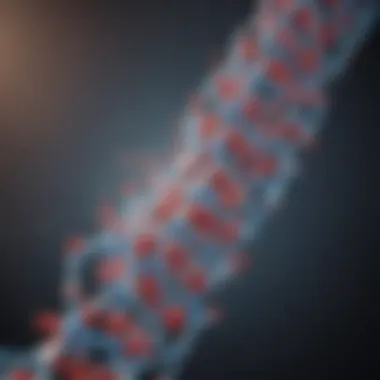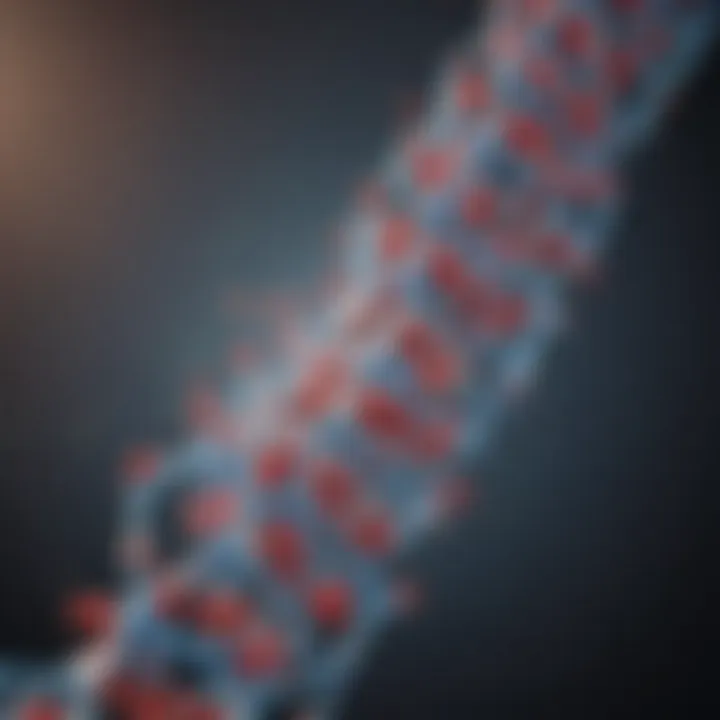RNA in Vaccines: Mechanisms and Future Impacts


Intro
Ribonucleic acid, commonly known as RNA, has taken center stage in the realm of vaccine development, reshaping our understanding and approach to immunization. This is not just a scientific breakthrough; it’s about harnessing nature's own machinery to elicit a potent immune response against various diseases. With the advent of messenger RNA (mRNA) technology, the landscape has changed dramatically, leading to quick and effective vaccines, particularly showcased during the recent global health crisis.
The intricate role of RNA in the body, especially in how it operates within cells, demonstrates its significance as a messenger, a catalyst, and a facilitator. Understanding these roles not only provides insights into basic biology but also opens a window to innovative therapeutic strategies that can tackle some of the most pressing health challenges known today.
Prepare to journey through the historical pathways that have led us to today's RNA-based vaccine technologies. Here, we’ll explore not only the science underpinning RNA vaccination but also the broader implications it holds across various fields such as medicine, genetics, and public health.
Prologue to RNA in Vaccines
The advent of RNA technology in vaccines marks a pivotal point in the ongoing battle against various diseases. With the swift rise of messenger RNA (mRNA) vaccines during the COVID-19 pandemic, the significance of this innovation cannot be overstated. Understanding the fundamentals of RNA in vaccines provides a clear window into how modern medicine is shifting towards more sophisticated solutions. Through examining the mechanisms at play, we can appreciate not only the immediate benefits but also the broader implications this technology holds for global health.
In this article, we’ll delve into various dimensions of RNA vaccines, exploring their mechanisms, advantages, challenges, and potential future innovations. This exploration forms a vital part of contemporary vaccine discourse and provides insights into how RNA can potentially reshape the landscape of immunotherapy.
Understanding RNA: A Brief Overview
To understand the role of RNA in vaccines, we first need a concise look at what RNA is, specifically its function and structure. Ribonucleic acid, or RNA, is a molecule essential for coding, decoding, regulation, and expression of genes. Unlike its counterpart, DNA, RNA is typically single-stranded, allowing for a range of functions, from acting as a messenger carrying instructions from DNA for controlling the synthesis of proteins to playing roles in catalyzing biochemical reactions.
In the context of vaccines, RNA plays a crucial role in instructing cells to produce antigens that prompt an immune response. By mimicking natural infection without causing the disease itself, RNA vaccines prepare the body to recognize and combat potential threats more effectively.
The Historical Context of Vaccination
Vaccination as a concept has a rich history going back to the late 18th century, starting with Edward Jenner's smallpox vaccine. Over the decades, this basic idea evolved. Traditional vaccines typically used weakened or inactivated forms of pathogens, which, while effective, had limitations such as slower development processes and potential safety concerns.
Enter the age of molecular biology, where groundbreaking techniques have transformed how vaccines can be created. Understanding this historical backdrop allows for insights into why and how RNA vaccines have emerged. By utilizing RNA, scientists can sidestep many of the inherent challenges of traditional vaccines. For instance, mRNA vaccines can be developed more rapidly, a crucial factor in responding to pandemics.
"The speed and adaptability of mRNA vaccines have redefined our approach to global health emergencies."
"The speed and adaptability of mRNA vaccines have redefined our approach to global health emergencies."
Through this lens, appreciation of the evolution of vaccinations naturally leads to recognition of the transformative impact of RNA technology. As we explore further into the types, mechanisms, benefits, and future perspectives of RNA vaccines in this article, we’ll uncover an evolving dialogue that intertwines history, scientific innovation, and public health, enriching our understanding of modern medicine.
Types of RNA Used in Vaccines
The emergence of RNA technology in the field of vaccines marks a significant shift in how we approach immunization. This section thoroughly examines the various types of RNA utilized in vaccine development and their unique contributions to this rapidly evolving landscape. Understanding these distinctions not only sheds light on their mechanisms but also highlights the specific applications and their implications for public health.
Messenger RNA (mRNA) Vaccines
Messenger RNA vaccines have taken center stage in recent years, particularly due to their pivotal role in combatting the COVID-19 pandemic. These vaccines work by introducing a strand of synthetic mRNA into the body, which instructs cells to produce a harmless piece of protein specific to a virus. This prompts the immune system to recognize the protein as a foreign entity, stimulating an immune response.
The charm of mRNA vaccines lies in their speed of development. Unlike traditional vaccine approaches that often require growing live virus in the lab, mRNA vaccines bypass this lengthy process entirely. This rapid development timeline was crucial in getting COVID-19 vaccines, like those by Pfizer-BioNTech and Moderna, into distribution within a year of the virus's outbreak. Furthermore, mRNA can be quickly adjusted to target new variants of a virus, providing a dynamic tool for public health.
- Benefits of mRNA Vaccines:
- Rapid production and adaptability to new strains.
- Strong immune response elicited due to the presentation of proteins.
- Non-infectious, as no live virus is involved.
Despite their promise, mRNA vaccines are not without challenges, such as the need for cold storage to maintain stability. This creates logistical hurdles, especially in resource-limited settings.
Self-Amplifying RNA Vaccines
Self-amplifying RNA vaccines take things a step further. These vaccines include a mechanism that allows the RNA to replicate itself once inside the host cells. As a result, a relatively small dose of RNA can produce a larger amount of antigen, enhancing the immune response without the need for higher quantities of vaccine components.
This feature is particularly appealing for vaccination efforts against viruses that require a strong immune response. The technology is still in the experimental stages for many applications but holds promise for greater efficacy through lower doses. Furthermore, the improved amplification may lead to a stronger and longer-lasting immunity.
"Self-amplifying RNA technologies may redefine the future of vaccination by optimizing immunogenicity and minimizing production costs."
"Self-amplifying RNA technologies may redefine the future of vaccination by optimizing immunogenicity and minimizing production costs."
Other RNA Platforms
Beyond mRNA and self-amplifying RNA vaccines, there are other RNA-based platforms on the horizon. These include RNA replicon vaccines and DNA vaccines that utilize RNA intermediates for gene delivery. While these technologies are not as mainstream, they present intriguing alternatives for vaccine development.
- Characteristics of Other RNA Platforms:


- RNA Replicon Vaccines: Utilize RNA that can replicate inside host cells without requiring a viral infection.
- DNA Vaccines with RNA Intermediates: Implement a two-step process where DNA is introduced to cells, transcribing RNA that then produces the necessary antigens.
Mechanisms of RNA Vaccines
Understanding how RNA vaccines function is at the heart of their revolutionary approach to immunization. Unlike traditional vaccines, which often introduce a weakened or inactivated form of a virus, RNA vaccines take advantage of the body’s own cellular machinery to produce the target antigen. This unique method not only expedites the development and production process but also enhances the efficacy of immune responses. This section delineates the fundamental mechanisms involved in RNA vaccines by examining the following aspects: how these vaccines work, the activation of the immune response they incite, and the intricate processes of antigen presentation.
How RNA Vaccines Work
RNA vaccines primarily utilize messenger RNA, or mRNA, as the core element of their composition. When administered, mRNA is taken up by the host's cells along with lipid nanoparticles that facilitate its delivery. This mRNA serves as a blueprint, instructing the host cells to synthesize specific proteins that are identical to portions of the pathogen.
- Delivery Mechanism: Once the mRNA enters a cell, ribosomes—molecular machines within the cell—read the mRNA sequence to produce the corresponding protein. This protein often resembles a part of a virus, such as the spike protein of SARS-CoV-2.
- Protein Expression: After the protein is synthesized, it is displayed on the cell's surface. This exposure is crucial as it triggers an immune response.
- Decaying of mRNA: Eventually, the mRNA is broken down by the cellular machinery, which is a normal part of RNA life cycle. The transient nature of mRNA ensures that it does not persist within the body, minimizing potential long-term effects.
The concise nature of this approach allows for rapid adaptations to emerging pathogens, thereby positioning RNA vaccines as a cornerstone of modern vaccine development.
Immune Response Activation
The activation of the immune response is a multifaceted process initiated by the expression of the antigen. When the proteins are presented on the surface of infected cells, several immune cells kick into high gear:
- Antigen-presenting Cells (APCs): Cells such as dendritic cells play a pivotal role here. They engulf the synthetic protein and process it before presenting it to T cells.
- T Cell Activation: Two types of T cells are activated:
- B Cell Activation: The activation of B cells leads to the production of antibodies that specifically target the synthesized protein, thus enhancing the body’s capability to neutralize the authentic pathogen if encountered in the future.
- CD4+ T Cells: These helper T cells assist in orchestrating the immune response by signaling B cells to produce antibodies.
- CD8+ T Cells: Cytotoxic T cells are directly involved in identifying and destroying infected cells.
"An effective immune response is akin to a well-rehearsed symphony, where each player knows their part and timing to achieve a harmonious outcome."
"An effective immune response is akin to a well-rehearsed symphony, where each player knows their part and timing to achieve a harmonious outcome."
Antigen Presentation Mechanisms
The presentation of antigens is essential for ensuring that the immune system correctly identifies and responds to threats. RNA vaccines revolutionize this process in various ways:
- MHC Molecules: Major Histocompatibility Complex (MHC) molecules on the surface of cells display the processed antigen to T cells. MHC Class I brings the peptide to CD8+ T cells, while MHC Class II presents it to CD4+ T cells.
- Immune Memory Formation: Through these antigen presentation mechanisms, the body not only reacts to the current threat but also creates a memory bank. Memory T and B cells are generated that can mount a rapid response upon re-exposure to the actual pathogen. Reporting to have a swift and effective defense against familiar intruders.
This robust process underlines the elegance of RNA vaccines in generating a comprehensive immune response, setting a new standard in preventative medicine and therapeutic avenues.
Applications of RNA Vaccines
The topic of RNA vaccines is increasingly becoming a cornerstone in various medical fields. Their applications extend beyond mere vaccination against infectious diseases, venturing into realms that include cancer treatment and other therapeutic avenues. Understanding the versatility of RNA vaccines can shed light on their potential benefits and implications for global health.
RNA Vaccines for Infectious Diseases
RNA vaccines, particularly those using messenger RNA (mRNA), have been game-changers in the fight against infectious diseases. The prime example that comes to mind is the rapid development of the Pfizer-BioNTech and Moderna COVID-19 vaccines. These vaccines utilized a novel approach, allowing for quick adaptation to rapidly mutating viruses.
The significance lies in how these vaccines instruct cells to produce a harmless protein unique to the virus, ultimately training the immune system to recognize and combat the real virus. This method not only speeds up the response time when a new infectious disease emerges but also enhances the efficacy of the immune response.
Moreover, RNA vaccines are not a one-trick pony. They are being explored for use against a variety of pathogens, including the Zika virus and influenza. This broad applicability underscores their potential to revolutionize vaccine development.
Potential in Cancer Immunotherapy
While the initial spotlight on RNA vaccines has mostly been regarding infectious diseases, their potential role in cancer immunotherapy cannot be overstated. Cancer cells often express unique antigens that are different from normal cells, providing an opportunity for RNA vaccines to exploit these differences.
By encoding for tumor-specific antigens, RNA vaccines can stimulate an immune response that specifically targets cancerous cells. Trials have shown promising results in using RNA vaccines to treat melanoma and other types of cancer. The ability to personalize these vaccines by tailoring them to the individual’s tumor profile offers a glimpse into a future where cancer treatment could be much more effective.
"The potential of RNA vaccines in cancer treatment could signal a radical shift in how we approach oncology, with individualized treatments becoming a reality."
"The potential of RNA vaccines in cancer treatment could signal a radical shift in how we approach oncology, with individualized treatments becoming a reality."
Other Therapeutic Opportunities
Beyond infectious diseases and cancer, RNA vaccines may hold the key to various therapeutic applications. For instance, researchers are exploring their use in autoimmune diseases and chronic conditions. The ability to generate specific immune responses could help modulate the immune system in a way that directly addresses these ailments. Furthermore, RNA vaccines have the potential to facilitate treatments for allergies as well.
These technologies might eventually lead to breakthroughs in how we approach diseases like diabetes or neurodegenerative disorders, harnessing the body’s own defense mechanisms to either prevent or treat these conditions. The landscape is ripe for exploration, with a multitude of avenues available for RNA applications, making it an exciting field both for research and practice.
Advantages of RNA Vaccines
The advent of RNA vaccines has ushered in a promising era in immunization technology. Unlike their traditional counterparts, RNA vaccines come with a unique set of advantages that could redefine how we approach disease prevention and treatment. Understanding these benefits not only highlights their importance but also sets the stage for their broad application in various fields of medicine.


Rapid Development and Production
One of the key benefits of RNA vaccines is the speed of development and production. This agility can be attributed to the nature of the RNA itself. Typically, creating a protein-based vaccine requires lengthy processes, which includes growing specific viruses or their parts in labs. In stark contrast, RNA vaccines can be synthesized in a matter of weeks.
For example, during the COVID-19 pandemic, Pfizer-BioNTech and Moderna swiftly produced their mRNA vaccines less than a year after the virus was identified. This quick turnaround made it possible to respond to an urgent global health crisis where time was of the essence. The ability to produce these vaccines with astonishing rapidity poses a game-changing advantage in addressing emerging infectious diseases, potentially saving thousands of lives.
Strong Immune Response
RNA vaccines have proven to evoke a robust immune response. When injected, these vaccines instruct cells to produce a harmless piece of the target pathogen, often a protein. This process activates the body’s immune system, prompting the production of antibodies and activating T-cells to attack infected cells. As a result, the individual experiences an immune response similar to that of an actual infection.
Research has shown that mRNA vaccines can lead to a more potent and durable immune response compared to conventional vaccines. In clinical trials for the COVID-19 vaccines, significant antibody levels were observed, providing potentially long-lasting protection.
"The immune response generated by mRNA vaccines has been likened to a wake-up call for the immune system, awakening it and training it to respond more effectively to real threats."
"The immune response generated by mRNA vaccines has been likened to a wake-up call for the immune system, awakening it and training it to respond more effectively to real threats."
Versatility in Targeting Pathogens
Another standout feature of RNA vaccines is their versatility. Unlike traditional vaccines that are often tailored to specific pathogens, RNA-based technologies can be adapted to target a wider variety of infections. This adaptability is especially crucial when facing well-known pathogens like influenza viruses or emerging threats such as Zika or Ebola.
The flexibility also extends to the potential use of RNA vaccines in cancer therapy. Tumors often harbor unique proteins that the immune system fails to recognize. However, with the encoding capabilities of RNA vaccines, researchers can create vaccines that specifically target these cancer markers, leading to tailored treatment options.
To underscore, the versatility of RNA vaccines doesn’t just end at infectious diseases or cancer; current research suggests applications in autoimmune disorders and even allergies.
In summary, the advantages of RNA vaccines stretch beyond rapid production and robust immune responses. They encapsulate the essence of adaptability, showing that this innovative approach can be harnessed to meet the complex challenges posed by various health threats in the world today.
By embracing the unique features of RNA technology, we can pave the way for a future rich with potential breakthroughs in vaccine and therapeutic design.
Challenges in RNA Vaccine Development
The area of RNA vaccine development, while promising, is not without its hurdles. These challenges have significant implications for the speed and effectiveness of rolling out these vaccines to the public. Addressing issues such as stability, manufacturing, and immunogenicity is crucial not only for the advancement of technology but also for ensuring public trust and safety in vaccination programs.
Stability and Storage Issues
One of the primary concerns with RNA vaccines is their stability, particularly when it comes to storage. RNA molecules are inherently fragile. They can quickly degrade when exposed to certain environmental conditions such as heat or moisture. This poses a real challenge for distribution, especially in regions lacking proper storage facilities. The most widely discussed example is the Pfizer-BioNTech vaccine, which requires ultracold storage at temperatures as low as -70 degrees Celsius.
This extreme requirement complicates logistics. If the vaccine cannot be kept at the necessary temperature, it may lose its effectiveness. Researchers are actively working on finding ways to stabilize RNA for longer periods, including using various formulations and stabilization techniques. Packaging solutions that allow for safe transport under varied conditions are equally critical. These enhancements might pave the way for broader global distribution and access.
Manufacturing Complexities
The manufacturing process for RNA vaccines is another critical point of concern. Not only must the production meet rigorous regulatory standards, but it must also scale effectively in response to global needs. The synthesis of mRNA involves not only constructing the nucleotides but also ensuring correct folding and modifications. This complexity can lead to production bottlenecks. For instance, the sudden spike in demand for COVID-19 vaccines highlighted how existing facilities struggled to keep up with the output needed at the peak of the pandemic.
Production requires high-quality materials, which can be expensive and difficult to source. A lot of attention is currently being invested in creating more efficient manufacturing processes. Innovations in bioreactors and purification techniques could help ramp up production while reducing costs, leading to a sustainable pipeline for future RNA vaccines.
Immunogenicity Concerns
The immunogenicity of RNA vaccines – that is, their ability to stimulate a strong immune response – is yet another challenge in their development. While these vaccines have been shown to induce robust immune reactions, variability can occur based on several factors. Each individual’s immune system may react differently due to genetic predispositions or prior exposure to viruses.
Furthermore, the delivery method of RNA also plays a crucial role. Lipid nanoparticles are often employed to facilitate the transport of RNA into cells, but questions linger regarding how effectively they operate across diverse populations. Understanding these variances is essential to refine vaccine formulations, ensuring they provide adequate protection across different demographic groups. Researchers are examining how to tailor vaccines to enhance immunogenicity, with special attention towards the need for booster doses and their timing.
Addressing these challenges is pivotal for the success and acceptance of RNA vaccines in public health strategies, influencing both future innovations and worldwide vaccination efforts.
Addressing these challenges is pivotal for the success and acceptance of RNA vaccines in public health strategies, influencing both future innovations and worldwide vaccination efforts.
Safety Considerations
When discussing the potential of RNA vaccines, safety is always at the forefront of the conversation. This includes analyzing and understanding the various side effects and long-term health implications associated with these innovative technologies. Gaining insights into safety considerations can significantly shape public perception and acceptance of RNA-based immunizations.
It's crucial to address concerns, provide transparent information, and ultimately foster trust in the scientific approach to health. While the benefits of RNA vaccines may be apparent, one cannot ignore the necessity of ensuring they are safe and effective for widespread use.
Side Effects and Reactions
The side effects of RNA vaccines are much like those accompanying traditional vaccines. Common reactions include local pain at the injection site, fatigue, headache, and mild fever. Depending on the individual, some might also experience more systemic responses, such as chills or muscle aches. These side effects typically serve as indicators that the body is mounting an immune response, rather than signifying a health crisis.
Most side effects resolve within a few days, presenting no long-term problem. Nonetheless, it is paramount that ongoing monitoring continues. Understanding rare occurrences of adverse reactions has bolstered the vigilance of regulatory bodies. For instance, rare allergic reactions, though infrequent, warrant systematic data collection to observe patterns and manage risks promptly.


"Continuous surveillance is imperative; it ensures that any potential risks are identified and addressed swiftly."
"Continuous surveillance is imperative; it ensures that any potential risks are identified and addressed swiftly."
Long-Term Health Considerations
Delving into the long-term health implications of RNA vaccines invites a careful exploration of the biological mechanisms at play. One concern has been whether mRNA might integrate into the genome or provoke unforeseen reactions over time. Current scientific consensus suggests that mRNA vaccines do not alter DNA. Instead, mRNA acts as a template for building proteins, and once it's done, it degrades naturally.
Still, comprehensive studies are needed to monitor effects over many years. Regulatory agencies often require long-term follow-up studies, analyzing both safety and efficacy data to ensure public safety.
In addition, there is room for exploration regarding the persistence of immunity and potential adjustments in the vaccine architecture. As more RNA vaccines enter the market, it’s imperative to track their longitudinal effects on health outcomes globally. This will cocoon both patients and healthcare providers in data-driven methodologies for safety oversight.
Thus, while the immediate reactions to RNA vaccines are important, maintaining an eye on the long-term health landscape will be equally essential in fostering trust and enhancing vaccine uptake.
Future Perspectives of RNA Vaccines
The role of RNA vaccines is continuously evolving, leading us to ponder their future in the realm of medicine. As we stand at the crossroads of innovation and healthcare, it’s essential to consider how these vaccines will shape public health, therapies, and overall medicine. The combination of rapid advancements in technology and rising global health challenges underscores the importance of exploring future perspectives on RNA vaccines.
Innovations on the Horizon
Exciting innovations loom on the horizon for RNA vaccines, potentially transforming how we approach infectious diseases and even cancer treatment. For instance, researchers are currently investigating various methods to enhance the stability and the delivery of RNA during vaccination. One promising avenue includes the development of lipid nanoparticles that can transport RNA more effectively into cells, boosting the immune response.
In addition, the field is exploring personalized RNA vaccines tailored to individual cancer profiles. This tailored approach can create vaccines that specifically target the unique mutations present in a patient’s tumor, paving a path toward more effective cancer treatments.
- Some Innovations Expected in RNA Vaccines include:
- Novel delivery systems like virus-like particles.
- Enhanced adjuvants to boost immune reactions.
- Combinations of RNA vaccines with conventional therapies.
Moreover, the integration of artificial intelligence and machine learning can expedite vaccine design by predicting the best candidates for triggering immune responses. This technology, while still in its infancy, could revolutionize vaccine development cycle time and success rates.
The future of RNA vaccines hinges not just on scientific inquiry, but also on their adaptability and integration into existing healthcare frameworks, ultimately determining their impact on global health challenges.
The future of RNA vaccines hinges not just on scientific inquiry, but also on their adaptability and integration into existing healthcare frameworks, ultimately determining their impact on global health challenges.
RNA Vaccines in Global Health Policy
As RNA vaccine technology matures, its implications extend far beyond the laboratory. They pose questions about global health policy and governance. The success of RNA vaccines in combating pandemics like COVID-19 has forced governments to reconsider how they approach vaccine development and distribution.
In particular, global collaborations could be a key pillar in this new era. Countries can benefit significantly from sharing knowledge and resources, helping to overcome regulatory barriers and ethical considerations that often hinder rapid vaccine deployment.
- Considerations for Global Health Policy in RNA Vaccines include:
- Establishing international consortia for research and development.
- Creating fair pricing structures to ensure accessibility.
- Developing stringent safety regulations for emerging RNA technologies.
Additionally, RNA vaccines can serve as a model for rapid response mechanisms during future public health emergencies. By putting policies in place that expedite regulatory approvals and production processes, nations can be better equipped to handle viral outbreaks or emerging diseases. This proactive stance could mean the difference between a localized outbreak and a widespread pandemic.
As we contemplate the trajectory of RNA vaccines, it’s clear they hold the potential not only to save lives but also to reshape the landscape of global health policy. With thoughtful consideration and collaboration, their future could be as impactful as their promise.
End
In the expansive field of vaccine research, the significance of RNA cannot be overstated. This article has traversed the remarkable journey of RNA in vaccine development, providing insights into its mechanisms and impacts. As we arrive at this conclusion, it's crucial to distill the key elements we’ve explored.
Summarizing Key Insights
Throughout our discussion, we delved into several pivotal aspects that highlight why RNA vaccines have gained prominence:
- Mechanistic Foundations: We painted a clear picture of how mRNA vaccines function—using the cells' own machinery to produce antigens, which subsequently incite an immune response that fortifies defenses against diseases.
- Applications and Potential: RNA vaccines have emerged not just as a response to infectious threats but also show promise in oncological domains, addressing cancer through immunogenic tactics. This versatility opens countless avenues for future applications.
- Advantages Over Traditional Methods: The rapid development timelines paired with robust immune responses present RNA technologies as front-runners in vaccine innovation. Notably, they can be tailored to target various pathogens swiftly.
- Challenges to Address: While the potential is vast, hurdles such as stability, storage, and manufacturing complexities remain challenges that need consideration. Understanding these issues is vital for the progression of RNA technologies into mainstream use.
"RNA-based vaccines mark a transformative leap in medical science, reshaping our approach to health and disease."
"RNA-based vaccines mark a transformative leap in medical science, reshaping our approach to health and disease."
As we reflect on these insights, the landscape of RNA vaccines appears promising indeed, leading us to contemplate the next chapter in their evolution.
The Future of RNA in Medicine
Turning our gaze toward the horizon, the future of RNA in medicine looks bright, if not a bit daunting. With ongoing research and technological advancements, the evolution of RNA vaccines is expected to further consolidate their place in healthcare. Here are some prospects:
- Novel Therapeutic Strategies: The potential exists for RNA to be harnessed in treating a variety of conditions beyond infectious diseases. With its ability to encode proteins, the horizon for developing vaccines against complex diseases is broadening.
- Improved Formulations: Continuous advancements in lipid nanoparticles and delivery systems promise improved stability and efficacy, lowering the barriers to widespread RNA vaccine usage.
- Broader Health Policy Implications: As RNA vaccines gain foothold in global health strategies, discussions on equitable access and regulatory frameworks will be paramount. This could reshape vaccination strategies worldwide, impacting public health policies significantly.
- Personalized Medicine Prospects: The versatility of RNA may also pave the way for personalized approaches, tailoring vaccines to individual genetic make-ups, essentially moving toward a more individualized treatment paradigm.
In summation, the journey of RNA in vaccine development has just begun. As scientists and researchers continue to unlock the full potential of RNA technologies, we can anticipate a future brimming with innovation, tailored health solutions, and enhanced global health outcomes.



